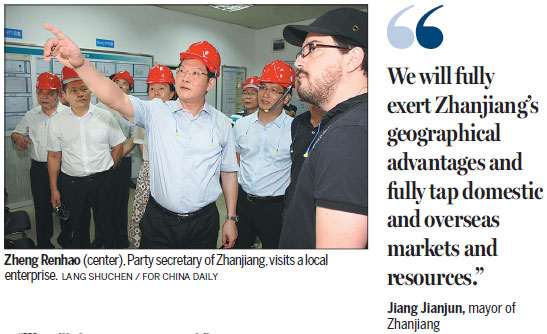Home> News
Zhanjiang to tap geographical advantages to aid development
Coastal city in Guangdong province looks to deepen economic, shipping, tourism links with neighbors
Zhanjiang in Guangdong province will establish wider connections with nearby cities and overseas markets to help its economy thrive, according to the city's top officials.
"We highlight the new development strategy of innovation, coordination, environmental protection, opening and sharing to make the city a new economic drive of the province," said Zheng Renhao, Party secretary of Zhanjiang.
The coastal city has the eighth largest economy of the 21 cities in Guangdong, with its GDP reaching 279 billion yuan ($44.2 billion) in 2017, representing year-on-year growth of 8 percent.
The city's Mayor Jiang Jianjun said: "We will fully exert Zhanjiang's geographical advantages and fully tap domestic and overseas markets and resources, to upgrade the city's opening-up to reach a bigger scale, a wider variety of sectors and a higher level."
A deputy to the 13th National People's Congress, Jiang made the remarks during the annual session of the legislative body in Beijing, which is scheduled to end on March 20. Zhanjiang is located at a strategic position where the provinces of Guangdong and Hainan, as well as the Guangxi Zhuang autonomous region meet.

Domestically, Zhanjiang aims to become more closely linked with the well-developed cities of Guangdong province, such as Shenzhen, Foshan and Zhuhai, by setting up industrial cooperation zones, the mayor said. As a part of the Beibu Gulf, which is encircled by the Leizhou Peninsula - where Zhanjiang is located - Hainan island, Guangxi and Vietnam, the city is seeking greater economic collaboration with its neighbors.
The city authorities have worked with other cities in the gulf to map out the area's overall transportation plan and promote the integration of ports and shipping resources.
The city has also tightened economic links across the Qiongzhou Strait that separates Zhanjiang and Hainan island, and has set up an economic cooperation zone with Beihai of the Guangxi.
Externally, Zhanjiang plans to advance its opening-up, with an emphasis on countries and regions involved in the Belt and Road Initiative, Jiang said.
"We will deepen cooperation in terms of business, trade, science, technologies and culture with the Association of Southeast Asian Nations, the European Union and countries and regions in South Asia, the Middle East and Africa," Jiang noted.
As a result, the city's businesses will become more competitive in the global markets for cane sugar, feedstuff, agricultural and marine products, home appliances and construction, to name a few, he added.
Zhanjiang has a spacious land area that covers 11,693 square kilometers, roughly 10 times the size of Hong Kong, or nearly six times larger than Tokyo.
Besides, as the Chinese city with the longest coast line at 1,243 kilometers, Zhanjiang boasts an even more spacious sea area that covers about 20,000 sq km. It has one of the best natural deepwater ports, which handled 900,000 twenty-foot equivalent units in 2017 and aims to surpass 1 million this year. The local government is applying to upgrade its deepwater channel, which is currently capable of allowing 300,000-metric-tonnage vessels to pass through, Jiang said.
After the planned improvements, which would allow 400,000 - tonnage ships through, the port would be a truly international passageway that would have direct sea traffic with more than 150 countries and regions, he said.
According to the mayor, Zhanjiang Bonded Logistics Center has a high priority on the local government's agenda, which will attract domestic and foreign companies involved in transportation, storage and shipping to set up regional centers in the city.
Zhanjiang Port is expected to develop into a South China distribution center for ironstone and petroleum, a logistics center for grain and chemical fertilizer from western and central China, an exchange center for bulk commodities and a regional transportation center for containers and bonded logistics, Mayor Jiang said.
Marine development is one of the city's main industrial strategies to revitalize its economy, along with enhancing major industrial projects' efficiency, upgrading traditional industries, and accelerating the development of modern services and high-tech industries.
Coastal tourism will also be an important part of the marine economy in the city.
A new ferry terminal at Xuwen in Zhanjiang is expected to be operated this year, which will reduce the time it takes to cross the Qiongzhou Strait to reach Hainan island from the current three hours to around one and a half hour. This will facilitate deeper tourism integration between Zhanjiang and Hainan, as the latter is becoming a world tourism destination, Jiang said.
"Zhanjiang and Hainan share some similarities in coastal tourism but their characteristics are different. Zhanjiang is lagging behind in the industry and we see this as a significant opportunity."
The city signed a tourism cooperation agreement with Haikou, capital city of Hainan, which encourages tourism companies from both cities to mutually develop travel routes and attract more tourists. The government is also seeking support from relevant departments to extend the incentive policies for Hainan travel companies to link up with Zhanjiang, according to the mayor.
In Zhanjiang, the government has introduced the OCT Group, a State-owned tourism and culture company based in Shenzhen, to design the road along the coastline of the Leizhou peninsula, inspired by the United States' Highway 1, Jiang said. The project will begin construction this year, he added.
"The road will connect all of the city's tourism attractions, including the coastal, cultural and rural features, which will accelerate tourism development."

 Print
Print Mail
Mail 5G construction supports Zhanjiang's high-quality development
5G construction supports Zhanjiang's high-quality development
 Acting mayor inspects project construction in Xuwen, Leizhou
Acting mayor inspects project construction in Xuwen, Leizhou Zhanjiang island an "egret paradise"
Zhanjiang island an "egret paradise"  Dancing egrets add vitality to Xiashan
Dancing egrets add vitality to Xiashan